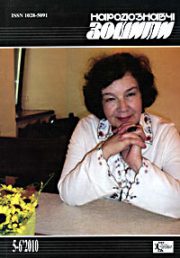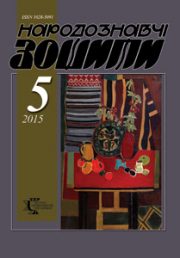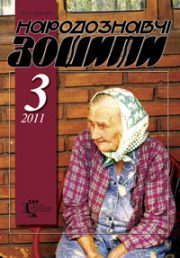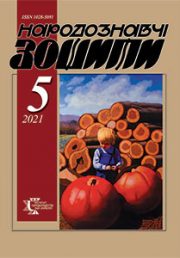The Ethnology Notebooks. 2022. № 5 (167), 1147—1163
UDK [391:[746.1.016.4:687.38]](477.8+474.5)
DOI https://doi.org/10.15407/nz2022.05.1147
PATTERNED WOVEN SASHESOF WESTERN UKRAINE AND LITHUANIA: TECHNIQUES, ORNAMENTATION, FUNCTIONS
NYKORAK Оlena
- ORCID ID: https://orcid.org/0000-0003-0887-8929
- Doctor in Art Studies, Professor,
- Leading Researcher,
- Ethnology Institute of the National Academy of Sciences of Ukraine,
- Folk Art Department,
- 15, Svoboda Avenue, 79000, Lviv, Ukraine,
- Contacts: e-mail: olenanykorak@gmail.com
HERUS Lyudmyla
- ORCID ID: https://orcid.org/0000-0002-5931-3816
- Doctor in History Sciences, Сandidate of Аrts (Ph. D),
- Senior Researcher,
- Ethnology Institute of the National Academy of Sciences of Ukraine,
- Folk Art Department,
- 15, Svoboda Avenue, 79000, Lviv, Ukraine,
- Contacts: e-mail: ludmilagerus@gmail.com
KUTSYR Tetiana
- ORCID ID: https://orcid.org/0000-0002-6522-0640
- Candidate of Art Studies (Ph. D.)
- Researcher,
- Ethnology Institute National Academy of Sciences of Ukraine,
- Folk Art Department,
- 15, Svoboda Avenue, 79000, Lviv, Ukraine,
- Contacts: e-mail: sonechko_29@ukr.net
Abstract. Based on the results of an interdisciplinary research project «Unique Technologies of Ethnographic Textile: Experience of Preservation in Western Ukraine and Lithuania» features of making, decoration and using of folk dress, traditions of Western Ukrainian and Lithuanian patterned woven sashes are studied. Within this research, ethnographic textiles appear not only as a phenomenon of material culture, but also as an object of the intangible cultural heritage of two countries, which has absorbed the technological knowledge, aesthetic ideas, and worldview positions of its creators. The commonalities between the items of both countries emphasize their long-standing historical ties, and the differences are the variability of the development of Ukrainian and Lithuanian ethnic artistic traditions.
The article purpose is to analyze the main making techniques, basic motifs and schemes, artistic and stylistic features of ornamental compositions, practical and ritual significance of patterned woven sashes in Western Ukraine and Lithuania.
The object of the research is preserved in museums items and reproduced by modern craftsmen and craftswomen, and the subject is the technological, artistic, and stylistic features of traditional woven Western Ukrainian and Lithuanian sashes, their significance in folk clothing, and their use in customs and rituals.
Structural analysis, modeling, and reconstruction methods were used to study sash-making techniques; art history and formal analysis were used to identify the characteristic features of the items decoration and its components; the comparative-historical method made it possible to analyze the similarities and differences between the Western Ukrainian and Lithuanian sashes, as well as the features of their use from the end of the XIX to the beginning of the XXI centuries.
The source base of the scientific article became: professional publications of Ukrainian and Lithuanian scholars in the field of traditional weaving, in particular, the making technology and ornamentation features of folk sashes; material items from the collections of Ukrainian and Lithuanian museums; practical trainings on the making of traditional sashes, carried out during the implementation of the project; materials of the authors’ long-term field research in Ukraine and Lithuania.
In the article, various ways of weaving Ukrainian and Lithuanian sashes were analyzed, and the regional and local uniqueness of their structure, texture, motifs, ornamentation, variability of composition schemes, and color scheme were revealed. Universal features of Ukrainian items ornamentation in historical and ethnographic regions of the western region of Ukraine and similar Lithuanian items are noted.
Keywords: Ukraine, Lithuania, weaving, sashes, technique, ornament, ritual, tradition.
Received 7.10.2022
REFERENCES
- Sydorovych, S. (1979). Art Fabrics of UkrSSR Western Regions. Kyiv: Naukova dumka [in Ukrainian].
- Nykorak, O. (2004). The Ukrainian Traditional Folk Cloths of XIX and XX cc. Interior Cloths (Based on Materials from Ukrainian Western Regions) (Part I). Lviv: Ethnology Institute of NAS of Ukraine [in Ukrainian].
- Hurhula, I. (1966). Folk Art of Ukrainian Western Region. Kyiv: Mystetstvo [in Ukrainian].
- Mateiko, K. (1977). Ukrainian Folk Clothing. Kyiv: Naukova dumka [in Ukrainian].
- Bilan, М.S., & Stalmashchuk, H.H. (2000). Ukrainian Costume. Lviv: Phenix [in Ukrainian].
- Zakharchuk-Chuhai, R., Pavliuk, S., & Hlushko, M. (Eds.). (1995). Folk Decorative Art. In Ukrainian Polissia. Historical and Ethnographic Research. Ovruchchyna (Issue 2, pp. 302—304). Lviv: NAS of Ukraine; Ethnology Institute [in Ukrainian].
- Kara-Vasylieva, T., & Borysenko, V. (1997). In Borysenko, V. Kholmshchyna and Pidliashshia: Historical and Ethnographic Research (Pp. 223—248). Kyiv: Rodovid [in Ukrainian].
- Ukrainets, А. (2019). Traditional Clothing of Rivne Region (Book 1). Rivne: U farvateri istyny [in Ukrainian].
- Pavlutskyi, H. (1927). Ukrainian Ornament History. Kyiv: Ukrainian Academy of Sciences [in Ukrainian].
- Stankevych, M. (Ed.). (2004). Pattern or Ornament? (Terminological, Ontological View, and More). Art Authenticity (Pp. 155—170). Lviv [in Ukrainian].
- Selivachov, M. (2005). Lexicon of Ukrainian Ornamentation (Iconography, Nomination, Styles, Typology). Kyiv: Ant [in Ukrainian].
- Poznanskyi, B. (1905). Little Russians` Clothing. In: Proceedings of the Twelfth Archaeological Congress in Kharkov, 1902 (Vol. ІІІ, pp. 178—210). Moskow: Tipografiya O-va raspostr. pol. knig, arend. V.I. Voronovym [in Russian].
- Zdoroveha, N.I. (1974). Essays on Wedding Ceremonies in Ukraine. Kyiv: Naukova dumka [in Ukrainian].
- Borysenko, V. (2016). Family Rituals of Ukrainians of the XX and early XXI Centuries. Kyiv: PH IAFE [in Ukrainian].
- Hvozdevych, S. (1997). Maternity Rituals of the Ukrainians. The Ethnology Notebooks, 2, 111—122 [in Ukrainian].
- Boriak, О. (1997). Weaving in the Rituals and Beliefs of Ukrainians (middle XIX — Early XX Centuries). Kyiv: PH IAFE [in Ukrainian].
- Nykorak, О. (2019). The Basic Features of Hutsul Home-Woven Sashes Decoration of the late XIX and middle XX Centuries. In: Materials Collection of the International Scientific and Practical Conference in Honor of Professor Petro Siredzhuk on the occasion of his 70th Anniversary (Pp. 252—279). Krakow; Iwano-Frankivsk; Kosmach: Werchy [in Ukrainian].
- Parkhomenko, Т. (2008). Basic Methods of Making Braided Sashes. Belt in Folk Beliefs and Customs. Proceeding of RRMLL (Issue IV, pp. 239—245). Rivne: Publisher Oleh Zen’ [in Ukrainian].
- Mikenaite, A., & Balcikonis, J. (Eds.). (1969). Lithuanian Folk Art Sashes. Vilnius: Vaga [in Lithuanian].
- Tamosaitiene, A., & Tamosaitis, A. (1988). Lithuanian Sashes. Toronto: Lithuanian Folk Art Institute.
- Juciene, M.T. (2010). Braided Sashes. Vilnius: Petro Ofsetas [in Lithuanian].
- Tumenas, V. (2002). Ornament of Lithuanian traditional pick-up woven sashes: typology and semantics. Vilnius: Diemedis [in Lithianian].
- Jurkuviene, T. (2001). Lithuanian Folk Sashes. Vilnius: Gervele [in Lithianian].
- Prychepiy, Ye., & Prychepiy, Т. (2007). Embroidery of Eastern Podillia. Kyiv: Rodovid [in Ukrainian].
- Woven sashes. The first half of the XX century. Zbarazh, Ternopil region. Ternopil Local History Museum. Inv. № ТКМ КН 15980, 15981 [in Ukrainian].
- Nykorak, О., & Pavliuk, S. (Ed.). (2020). Weaving. In: S. Pavliuk. Ethnographic groups of Carpathian Ukrainians. Boikos (Pp. 429—441) Kharkiv: Folio [in Ukrainian].
- Anniversary commemorative sashes with standard inscription. Online store «Ruta Zalioji». Retrieved from: https://www.rutazalioji.lt/produktas/jubiliejine-progine-juosta (Last accessed 29.09.2022) [in Lituanian].
- Malinowska, W. (1883). Wedding Rituals of the Ruthenian People in Kudynivci village, Zolochiv district. The collection of information on national anthropology, published by the Anthropological Committee of the Academy of Arts and Sciences in Krakow (Vol. VII, pp. 244—264). Krakow [in Poland].
- Herus, L. (2018). Bread and Cloth in Ukrainian Rituality: Functions and Semantics. The Ethnology Notebooks, 5 (143), 1096—1105 [in Ukrainian].
- Hrushevskyi, M. (2011). A child in the Customs and Beliefs of the Ukrainians. Kyiv: Lybid [in Ukrainian].







